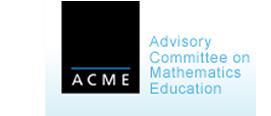Post-16 mathematics: planning for success
Provided by the Advisory Committee on Mathematics Education (ACME), these resources respond to Michael Gove’s speech at the Royal Society in June 2011, and to recommendations in reports such as Mathematical Needs and Is the UK an Outlier? They set out a strategy for dramatically increasing participation in Post-16 mathematics. As mathematics becomes increasingly important in both employment and in higher education, more people with skills in mathematics are needed beyond those required to obtain at least a C grade in GCSE Mathematics. The essential question to address is how to overcome this shortfall. In England, the number of students studying A level mathematics has been rising steadily for some time. This rise comes after a serious drop in participation following the introduction of Curriculum 2000, but nevertheless increasing numbers of students are opting to study AS and A level mathematics. Numbers studying AS and A level further mathematics have also risen dramatically.
However, despite this positive news, it is estimated that each year at least 250,000 students in England with a C or above in GCSE Mathematics choose not to study any mathematics after the age of 16. ACME suggest that a number of approaches will be required to change behaviours, for example funding requirements, accountability measures and a clear signalling of higher education and employment requirements.
A strategy for improving provision and participation - sets out the requirements and rationale for the development of a new post-16 qualification to sit within a clear, simple suite of distinctive and well understood post GCSE qualifications.
Planning for success - describes the actions that will need to be taken to improve participation in this new qualification.
Show health and safety information
Please be aware that resources have been published on the website in the form that they were originally supplied. This means that procedures reflect general practice and standards applicable at the time resources were produced and cannot be assumed to be acceptable today. Website users are fully responsible for ensuring that any activity, including practical work, which they carry out is in accordance with current regulations related to health and safety and that an appropriate risk assessment has been carried out.





